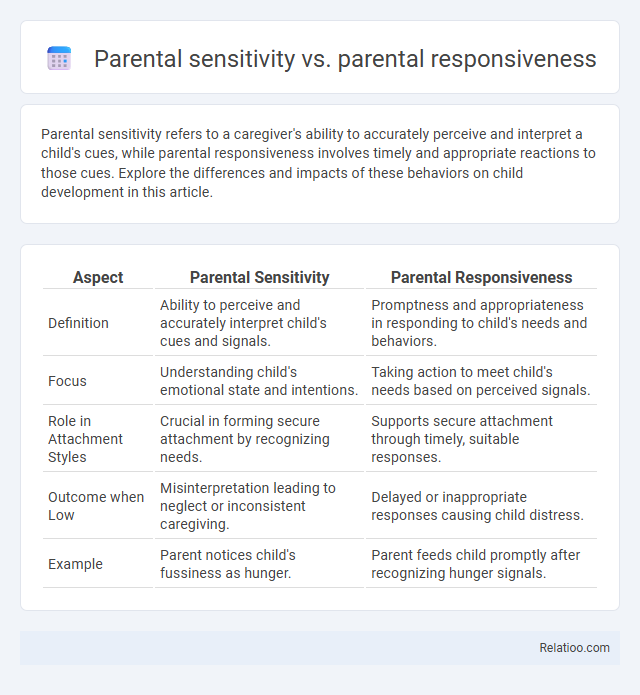Parental sensitivity refers to a caregiver's ability to accurately perceive and interpret a child's cues, while parental responsiveness involves timely and appropriate reactions to those cues. Explore the differences and impacts of these behaviors on child development in this article.
Table of Comparison
| Aspect | Parental Sensitivity | Parental Responsiveness |
|---|---|---|
| Definition | Ability to perceive and accurately interpret child's cues and signals. | Promptness and appropriateness in responding to child's needs and behaviors. |
| Focus | Understanding child's emotional state and intentions. | Taking action to meet child's needs based on perceived signals. |
| Role in Attachment Styles | Crucial in forming secure attachment by recognizing needs. | Supports secure attachment through timely, suitable responses. |
| Outcome when Low | Misinterpretation leading to neglect or inconsistent caregiving. | Delayed or inappropriate responses causing child distress. |
| Example | Parent notices child's fussiness as hunger. | Parent feeds child promptly after recognizing hunger signals. |
Defining Parental Sensitivity
Parental sensitivity refers to a caregiver's ability to accurately perceive, interpret, and appropriately respond to an infant's cues and signals, fostering secure attachment and emotional regulation. Parental responsiveness emphasizes the timeliness and appropriateness of reactions to a child's needs, reflecting active engagement and support. While closely related, parental sensitivity specifically highlights the nuanced understanding and interpretation of a child's signals, which forms the foundation for effective responsiveness and overall caregiving quality.
Understanding Parental Responsiveness
Parental responsiveness involves promptly and appropriately reacting to your child's cues and needs, fostering secure attachment and emotional development. While parental sensitivity emphasizes recognizing and interpreting a child's signals, parental responsiveness focuses on the timely and suitable actions taken after this recognition. Understanding parental responsiveness helps you create a supportive environment that meets your child's emotional and physical requirements effectively.
Key Differences Between Sensitivity and Responsiveness
Parental sensitivity involves accurately perceiving and interpreting your child's emotional and physical cues, while parental responsiveness refers to the timely and appropriate reactions to those cues. Sensitivity is the awareness and understanding of your child's needs, whereas responsiveness is the action taken based on that understanding. Both are crucial for secure attachment, but sensitivity emphasizes recognition, and responsiveness emphasizes reaction.
The Role of Sensitivity in Child Development
Parental sensitivity plays a crucial role in child development by enabling parents to accurately perceive and interpret their child's signals, fostering secure attachment and emotional regulation. Unlike parental responsiveness, which emphasizes timely reactions, sensitivity ensures these responses are attuned to the child's unique needs and cues, promoting optimal cognitive and social growth. Your awareness and practice of sensitive parenting can significantly enhance your child's emotional resilience and developmental outcomes.
The Impact of Responsiveness on Emotional Growth
Parental responsiveness significantly influences a child's emotional growth by fostering secure attachment and emotional regulation through timely and appropriate reactions to a child's needs. While parental sensitivity refers to the ability to perceive and interpret a child's cues accurately, responsiveness emphasizes the active and consistent behavioral responses that nurture emotional development. Research indicates that high parental responsiveness enhances emotional intelligence, reduces behavioral issues, and supports healthy social interactions in early childhood.
Measuring Parental Sensitivity and Responsiveness
Measuring parental sensitivity involves assessing a caregiver's ability to accurately perceive and interpret an infant's cues and respond appropriately, often using structured observational tools like the Ainsworth Sensitivity Scale. Parental responsiveness pertains to the timeliness and appropriateness of reactions to a child's signals, frequently evaluated through real-time interaction analysis and coding systems such as the Maternal Behavior Q-Sort. Both constructs are critical for understanding parent-child attachment quality, with sensitivity emphasizing accurate interpretation and responsiveness focusing on the execution of suitable behavioral responses.
Factors Influencing Sensitivity and Responsiveness
Parental sensitivity and responsiveness are influenced by factors such as parental mental health, infant temperament, and socio-economic conditions, which shape the ability to perceive and appropriately react to a child's cues. Sensitivity involves accurately interpreting a child's signals, while responsiveness emphasizes timely and consistent reactions; both are affected by stress levels, social support, and parenting experience. Understanding these distinctions aids in developing interventions that enhance parent-child attachment and developmental outcomes.
Real-life Examples: Sensitivity vs Responsiveness
Parental sensitivity involves accurately perceiving and interpreting a child's emotional cues, such as noticing when your baby feels tired and soothing them gently by rocking. Parental responsiveness goes a step further by not only recognizing these signals but also promptly and appropriately addressing your child's needs, like feeding your hungry toddler right after they start fussing. Real-life examples highlight sensitivity as understanding emotions without immediate action, while responsiveness combines this awareness with timely caregiving that fosters secure attachment and emotional development.
Enhancing Both Sensitivity and Responsiveness in Parenting
Parental sensitivity involves accurately perceiving and interpreting a child's cues, while parental responsiveness refers to timely and appropriate reactions to those cues. Enhancing both sensitivity and responsiveness strengthens your child's emotional security by fostering trust and effective communication. Integrating these elements in parenting promotes healthy development and resilience in children.
Practical Tips for Balanced Parenting
Parental sensitivity involves recognizing and interpreting your child's emotional cues accurately, while parental responsiveness focuses on appropriately addressing those needs in a timely manner. Achieving balanced parenting requires you to combine sensitivity by observing subtle signals with responsiveness through consistent, supportive actions that encourage emotional security. Practical tips include active listening, maintaining patience, and adapting responses to your child's changing developmental stages for optimal relational growth.

Infographic: Parental sensitivity vs Parental responsiveness
 relatioo.com
relatioo.com